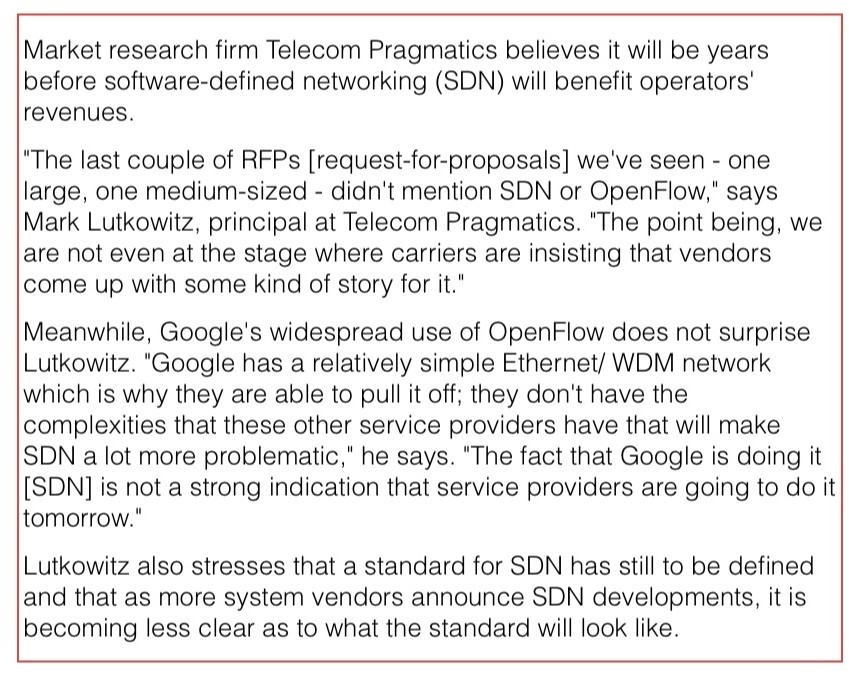OpenFlow extends its control to the optical layer
 Thursday, June 28, 2012 at 2:59PM
Thursday, June 28, 2012 at 2:59PM OpenFlow may be causing an industry stir as system vendors such as ADVA Optical Networking extend the protocol's reach to the optical layer, but analysts warn that it will take years before the technology benefits operators' revenues.

"We see OpenFlow as an additional solution to tackle the problem of network control"
Jörg-Peter Elbers, ADVA Optical Networking
The largest data centre players have a single-mindedness when it comes to service delivery. Players such as Google, Facebook and Amazon do not think twice about embracing and even spurring hardware and software developments if they will help them better meet their service requirements.
Such developments are also having a wider impact, interesting traditional telecom operators that have their own service challenges.
The latest development causing waves is the OpenFlow protocol. An open standard, OpenFlow is being developed by the Open Networking Foundation, an industry body that includes Google, Facebook and Microsoft, telecom operators Verizon, NTT and Deutsche Telekom, and various equipment makers.
OpenFlow is already being used by Google, and falls under the more general topic of software-defined networking (SDN). A key principle underpinning SDN is the separation of the data and control planes to enable more centralised and simplified management of the network.
OpenFlow is being used in the management of packet switches for cloud services. "The promise of software-defined networking and OpenFlow is to give [data centre operators] a virtualised network infrastructure," says Jörg-Peter Elbers, vice president, advanced technology at ADVA Optical Networking.
The growing interest in OpenFlow is reflected in the activities of the telecom system vendors that have extended the protocol to embrace the optical layer. But whereas the content service provider giants need only worry about tailoring their networks to optimise their particular services, telecom operators must consider legacy equipment and issues of interoperability.

OFELIA
ADVA Optical Networking has started the ball rolling by running an experiment to show OpenFlow controlling both the optical and packet layers of the network. Until now the protocol, which provides a software-programmable interface, has been used to manage packet switches; the adding of the optical layer control is an industry first, the company claims.
The OpenFlow demonstration is part of the European “OpenFlow in Europe, Linking Infrastructure and Applications” (OFELIA) research project involving ADVA Optical Networking and the University of Essex. A test bed has been set up that uses the ADVA FSP 3000 to implement a colourless and directionless ROADM-based optical network.
"We have put a network together such that people can run the optical layer through an OpenFlow interface, as they do the packet switching layer, under one uniform control umbrella," says Elbers. "The purpose of this project is to set up an experimental facility to give researchers access to, and have them play with, the capabilities of an OpenFlow-enabled network."
"The fact that Google is doing it [SDN] is not a strong indication that service providers are going to do it tomorrow"
Mark Lutkowitz, Telecom Pragmatics
Remote researchers can access the test bed via GÉANT, a high-bandwidth pan-European backbone connecting national research and education networks.
ADVA Optical Networking hopes the project will act as a catalyst to gain useful feedback and ideas from the users, leading to further developments to meet emerging requirements.
OpenFlow and GMPLS
A key principle of SDN, as mentioned, is the separation of the data plane from the control plane. "The aim is to have a more unified control of what your network is doing rather than running a distributed specialised protocol in the switches," says Elbers.
That is not that much different from the Generalized Multi-Protocol Label Switching (GMPLS), he says: "With GMPLS in an optical network you effectively have a data plane - a wavelength switched data plane - and then you have a unified control plane implementation running on top, decoupled from the data plane."
But clearly there are differences. OpenFlow is being used by data centre operators to control their packet switches and generate packet flows. The goal is for their networks to gain flexibility and agility: "A virtualised network that can be run as you, the user, want it," said Elbers.
But the protocol only gives a user the capability to manage the forwarding behavior of a switch: an incoming packet's header is inspected and the user can program the forwarding table to determine how the packet stream is treated and the port it goes out on.
And while OpenFlow has since been extended to cater for circuit switches as well as wavelength circuits, there are aspects at the optical layer which OpenFlow is not designed to address - issues that GMPLS does.
To run end-to-end, the control plane needs to be aware of the blocking constraints of an optical switch, while when provisioning it must also be aware of such aspects as the optical power levels and optical performance constraints. "The management of optical is different from managing a packet switch or a TDM [circuit switched] platform," says Elbers. “We need to deal with transmission impairments and constraints that simply do not exist inside a packet switch.”
That said, having GMPLS expertise, it is relatively simple for a vendor to provide an OpenFlow interface to an optical controlled network, he says: "We see OpenFlow as an additional solution to tackle the problem of network control."
Operators want mature and proven interoperable standards for network control, that incorporate all the different network layers and that use GMPLS.
"We are seeing that in the data centre space, the players think that they may not have to have that level of complexity in their protocols and can run something lower level and streamlined for their applications," says Elbers.
While operators see the benefit of OpenFlow for their own data centres and managed service offerings, they also are eyeing other applications such as for access and aggregation to allow faster service mobility and for content management, says Elbers.
ADVA Optical Networking sees the adding of optical to OpenFlow as a complementary approach: the integration of optical networking into an existing framework to run it in a more dynamic fashion, an approach that benefits the data centre operators and the telcos.
"If you have one common framework, when you give server and compute jobs then you know what kind of connectivity and latency needs to go with this and request these resources and reconfigure the network accordingly," says Elbers.
But longer term the impact of OpenFlow and SDN will likely be more far-reaching: applications themselves could program the network, or it could be used to enable dial-up bandwidth services in a more dynamic fashion. "By providing software programmability into a network, you can develop your own networking applications on top of this - what we see as the heart of the SDN concept," says Elbers. “The long term vision is that the network will also become a virtualised resource, driven by applications that require certain types of connectivity.”
Providing the interface is the first step, the value-add will be the things that players do with the added network flexibility, either the vendors working with operators, or by the operators' customers and by third-party developers.
"This is a pretty significant development that addresses the software side of things," says Elbers, adding that software is becoming increasingly important, with OpenFlow being an interesting step in that direction.



Reader Comments